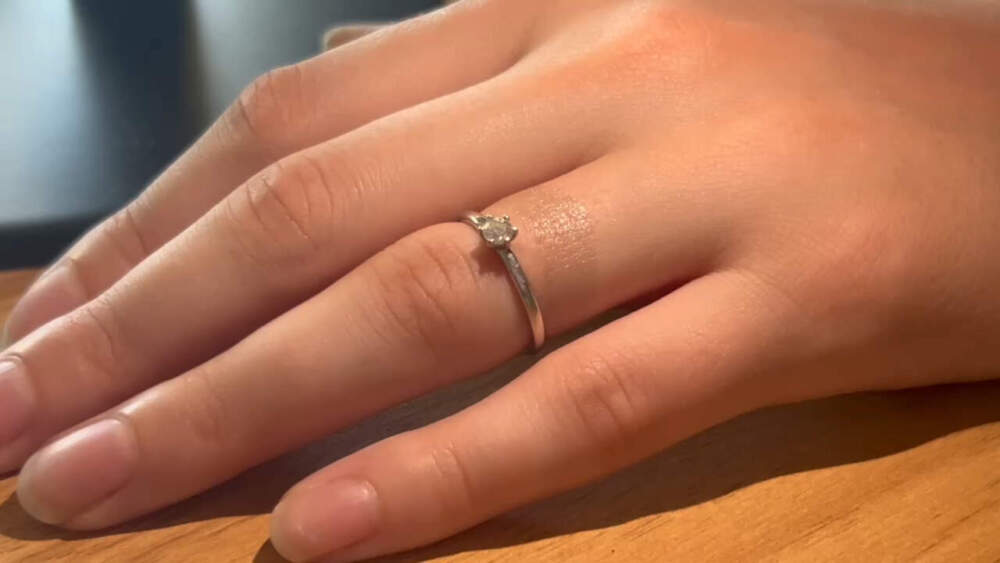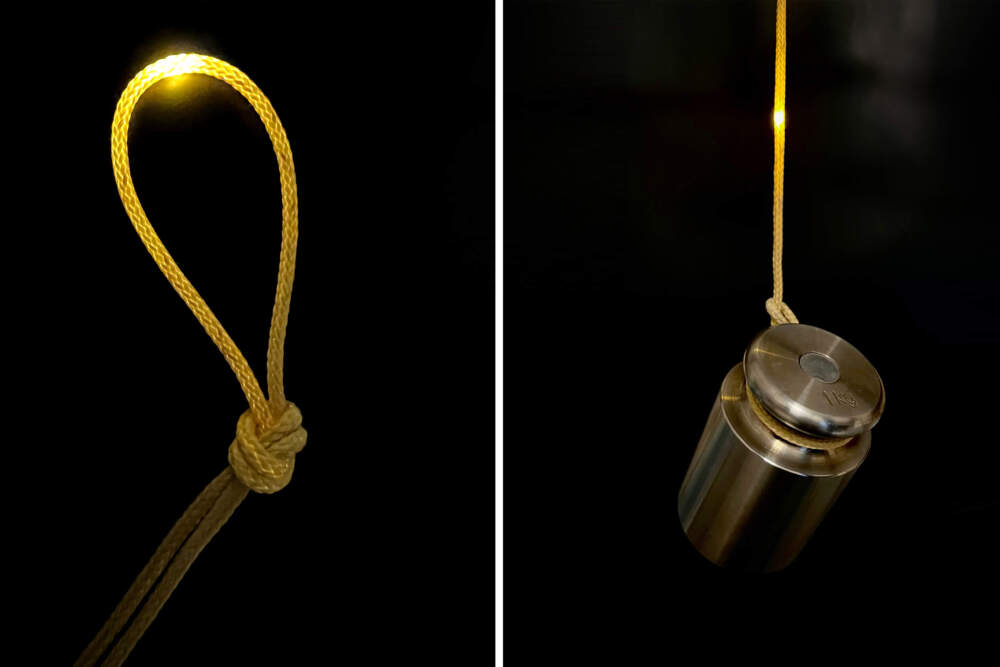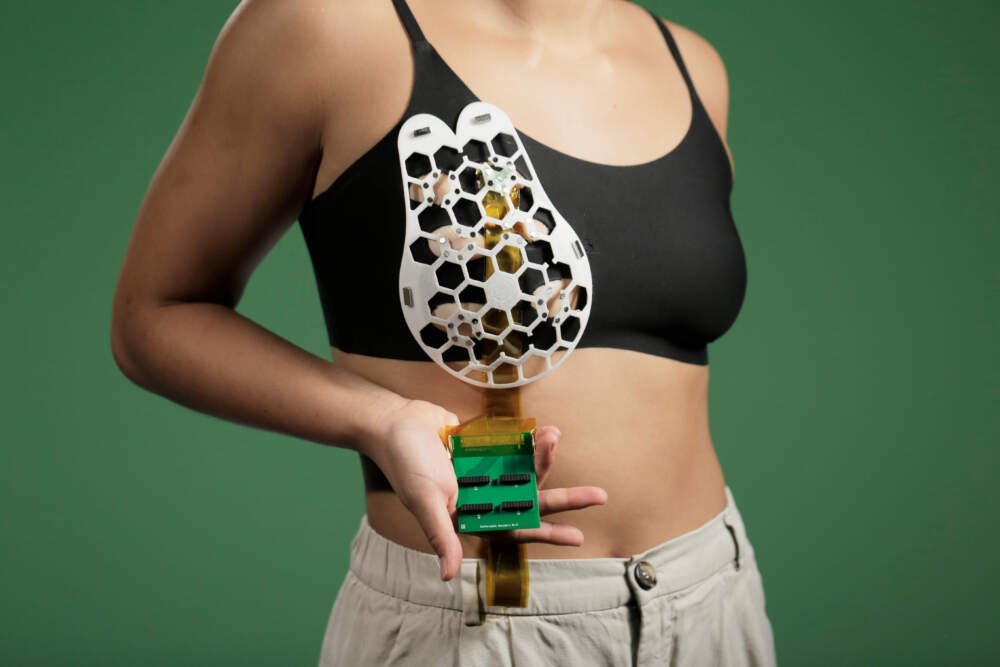Editor’s Note: This is an excerpt from WBUR’s weekly health newsletter, CommonHealth. If you like what you read and want it in your inbox, sign up here.
What if a tattoo could warn you that a heart attack was near? Or a bra could monitor your risk of breast cancer?
Devices like these could one day take the place of smartwatches, smart rings and fitness trackers. And several Massachusetts researchers say these wearables of the future will do even more for your health.
These scientists are developing “imperceptible” devices, meaning they are so comfortable they can be worn all day and forgotten about. By making them easier to keep on, researchers expect to collect more consistent data and give the wearers — and their doctors — a clearer picture of their overall health.

A health monitor that looks like a temporary tattoo
A team at UMass Amherst is taking the technique used to make temporary tattoos to create a medical tool that can measure the heart’s electrical activity.
The thin, graphite-based tattoo is gray, translucent and about the size of a quarter. It would function as a lightweight electrocardiogram, or EKG, and look for signs of hypertension, diabetes, stroke or heart attack.
The tool is powered by the body’s own electricity. It records data from the wearer, and eventually, the team hopes to transmit the data wirelessly to a smartwatch or computer.
“ There are a lot of exciting outcomes to get from this research, and it’s accessible for people,” said Dmitry Kireev, a biomedical engineer at UMass Amherst who’s leading the research.
Beyond heart monitoring, Kireev envisions applications that might range from measuring brain activity linked to stress or sleep, to tracking blood pressure. The device might even be able to gauge the lactic acid in your sweat after a workout.
“You can measure any electrical signal your body generates, right?” he said.
Right now, the tattoos last up to 24 hours. The team hopes to extend that to two to seven days, which would make them useful in hospitals. In intensive care units, the tattoos could replace some wired monitors, letting patients move more freely, while doctors continuously monitor their vital signs.
Kireev says commercial sales of the tattoos are probably at least a decade away, but early tests in a limited number of subjects found no side effects or skin irritation. Broader human testing hasn’t yet been conducted.

Clothing woven with computers
A peel and stick tattoo can measure signals from a single spot on the body, but MIT Professor Yoel Fink is working to weave computer power into your clothing. He’s developed a thread capable of storing data, running artificial intelligence algorithms, sensing motion and sound, and communicating through Bluetooth.
When integrated into larger fabric pieces, the threads can collect millions of data points a day. Fink has been wearing one of these garments to his lab in Boston’s Seaport district for months.
“If you came and saw me at MIT, this is what I’m wearing. And it’s collecting data,” he said. “Then the question is, ‘What could you learn from it, about me?’ ”
The answer could be a lot.
In trials, the fabric was able to recognize exercises and activities performed by the wearer with 70% accuracy. When researchers allowed the fibers to communicate with fibers on multiple parts of the body, the accuracy increased to 95%.
“Up until now, no one could say with certainty that a fabric could measure what a stethoscope can,” Fink said. “Now, once that happens, your fabric could become a diagnostic.”
The possibilities are broad: fabrics that monitor fetal heart rates in high-risk pregnancies, detect early signs of respiratory illness by “listening” to wheezes, analyze sweat chemistry, or even release medication on demand.
Fink calls it “fabric physiology.” His vision is a device that can track health autonomously, share data securely and blend seamlessly into everyday clothing.
“You’re not going to walk around with electrodes on your head,” Fink said. “But you are going to walk around with the fabric.”

A bra that screens for breast cancer
Another MIT researcher, Canan Dağdeviren, has a personal mission behind her effort to develop next generation wearable health technology. Her aunt died from an aggressive form of breast cancer that developed in between scheduled mammograms, known as “interval cancer.” So, Dağdeviren began sketching an idea for a bra that could perform breast tissue scans.
The design uses a flexible, 3D-printed patch that holds a small ultrasound scanner. Placed inside a bra, it can capture images from multiple angles in seconds — no special operator or uncomfortable machine needed. The scanner connects to a standard ultrasound machine to review the images.
While mammography is “quite amazing technology,” Dağdeviren said, “it’s quite bulky, and it’s 1960s technology. And it’s dependent on the operator’s skills.”
The curved design of her device seeks to make screening more comfortable and more accurate.
So far, the device has been tested on one patient, and detected early-stage abnormalities with accuracy comparable to a conventional ultrasound. Her team, in collaboration with Massachusetts General Hospital, is now running larger human trials to measure accuracy across different patient ages, breast densities and health histories.
“This is safe, non-radiative ultrasound,” Dağdeviren said. “The hope is that women at high risk, and eventually anyone, could check their breast tissue at home, as often as they want.”
The technology could one day have broader uses, she said, such as monitoring high-risk pregnancies, detecting ovarian or pancreatic cancer, or measuring bone density in older adults.
In the future, she expects wearable devices will be commonplace.
“We’ll be either carrying them on top of our skin,” she said, “or as part of our personal garments — bras, underwear, t-shirts, even shoes.”




No Comment! Be the first one.